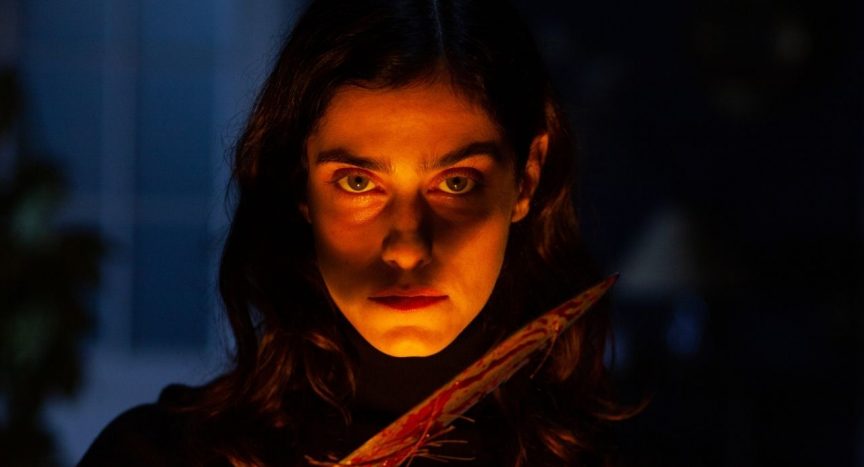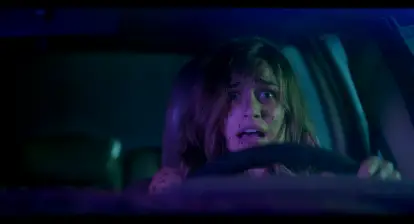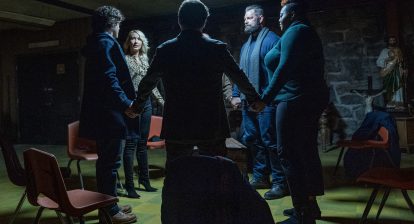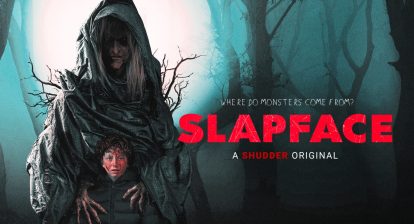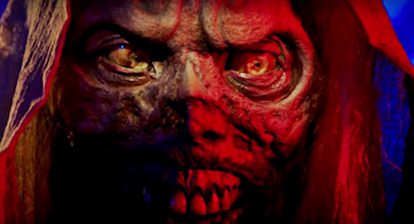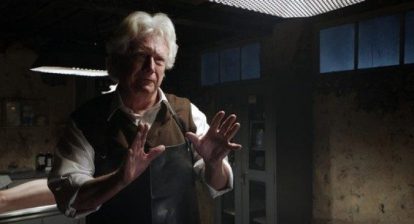On Dec. 2, writer/director Patrick Ridremont gifted horror fans with a feature fit for the holiday season, The Advent Calendar. Streaming now on Shudder, the festive film centers around Eva (Eugénie Derouand), an ex-dancer who is still adjusting to her new life as a paraplegic. On Eva’s birthday, her friend Sophie (Honorine Magnier) decides to cheer Eva up by giving her an ancient advent calendar. However, what starts out as a fun antique to play with soon reveals itself to be a monstrous force. Each day, Eva eats a candy to receive one surprise. Of course, each “gift” comes with a unique — and often bloody — price to pay too. In celebration of the Shudder Original horror film, Wicked Horror sat down with Ridremont to hear what went into the evil calendar’s creation and unpack some of the film’s trickest scenes to film.
Also See: The Advent of Holiday Horror: Sinister Santa Film Recommendations

Wicked Horror: I do not speak a lot of French, but I know enough to spot when English closed captions are slightly off. In The Advent Calendar‘s English translation, the characters’ dialogue comes across much more directly. Was there any aspect to the film you hope won’t get lost in translation? Or do you see it as a different but fine take?
Patrick Ridremont: Actually, because of the [time] period, I didn’t check the English subtitles. I just checked the Dutch ones. In Belgium, my country, we speak two languages. We imagined, “Okay, maybe the movie won’t go over the world. But I hope it will be over Belgium, my own country.” So for the north of my country, we made a Dutch translation. We were so surprised and so pleased to hear that Shudder wanted our movie. So I didn’t check the English translation, but I think it’s okay. I saw my previous movie with English subtitles and sometimes it was not exactly what they were saying — it was another version. And it was a good translation for me. It was fair enough. It was not what I meant, but that’s ok! [laughs]
Wicked Horror: The calendar itself is a character in The Advent Calendar. I would love to hear more about the process around creating the calendar — and what ideas might have gotten scrapped along the way?
Patrick Ridremont: We had so many calendars before the good one!
Actually, something I’m in love with in horror movies is when you have objects that pass through different movies — the characters, the actors die. They’re not there in the second chapter, but one of the objects stays. I wanted a horror movie with one object. What could it be? The Bible? No! Already done. [laughs] I found the advent calendar a good idea because there were so many windows, so many things to explain, so many scenes to explore. Sometimes the objects inside the calendar were big enough like the small car, the toy. So the designers said, “Okay, we should make a triptych, not just a calendar of one.” All we knew is what’s on Wikipedia — that the advent calendar was invented by a German priest in the 19th century. So this calendar looks like an end of 19th century object because we just imagined that it was the first one. It was the advent calendar and the only one. All the others are fake! [laughs]
Also See: The Advent of Holiday Horror: Creature Classic Viewing Recommendations

Wicked Horror: One of my favorite details in The Advent Calendar is the calendar’s candy and how their designs match up with the “gift” that Eva receives. Do you see them as a 1:1 connection? Or are some more ambiguous than others?
Patrick Ridremont: Okay, what I knew is if all the candies were killing candies, and if every day, every night at midnight, she found a candy, ate it, and the eyes turned to red and then she takes a knife to kill the dog on day one, then on day two she killed a friend — I’d have to get out of that routine. I imagine that some of the candies are killing people. Other ones are cool. Other ones are slow. Someone you can take a candy and one day is ten minutes long on-screen. Sometimes, you have four days in three seconds — because time is strange. That’s what I wanted to play with. Originally, I think it’s candies in it are just little bits of Bible folklore. That’s the religion we feed you. For me, it was really important because in a horror movie when you swallow things it’s, “Oh, don’t do that.” This calendar is more than 150 years old. There’s chocolate in it, and you really eat it? And it’s like, “Yes, I do.” That was fun for me.
Wicked Horror: Speaking of the calendar’s rules, one thing I liked about The Advent Calendar was how quickly Eva and Sophie believe in the object. Any one Eva tells about it, they believe her. In a lot of American horror films, we spend a lot of time debating if cursed objects are real — especially if a woman is saying it is. Why was this choice important for you?
Patrick Ridremont: It’s because in our European culture of movies, we do sometimes too realistic things. People are talking about the problem they have, the way they fall in love. We don’t really have fairy tales or horror movies — we don’t do that. Much of our cinema is really deep into social things. I don’t like social movies, but I’ve been born into that movie [culture]. That’s how we make movies here, and that’s the sensibility of people who are reading the screenplay and giving me the money. They wanted the real relationship between the two girls, [Eva and Sophie], and what was the problem before Eva was paralyzed? What happened there? They were really interested in that. And finally, what you saw, the feeling you have, it’s a drama film — and then, “Oh fuck there’s a monster!” Yeah, it’s a drama but it’s also a horror movie. Every actor that read the screenplay, they were saying, “Okay, this is another Belgian social drama about someone who can’t walk because she had an accident and then, ‘Oh, fuck, there’s a monster!'”
It’s really strange. Maybe in American movies, they in the first ten seconds, they buy a house, and they find a newspaper, and everybody has been killed the month before. They stop their car and there’s a crow. I love the kind of horror movie that have a social part, an allegory. I love It Follows because it’s not only a terror movie. It’s another story with something strange in it with it.
Also see: Four Well Known Actors Who Got Their Big Break in Horror Films
Wicked Horror: My favorite kill scene in The Advent Calendar is the dog/car scene. Without spoiling it, how many takes did it take to get that one right, to get the dog interacting with the toy car in just the right way?
Patrick Ridremont: The owner of the dog was there, the girl in love with the owner of the dog was there — so many people were there with the dog. You have to respect animals because it’s not for nothing that you have to write on-screen: No animals were hurt or killed in this movie. People know that an animal is not playing. They’re doing what you tell them to do. If you take the dog, and throw it away, the dog is not joking… Every time I see a movie, I always wonder what happened with the animal involved. Sometimes, they take a chicken and they cut the neck of the chicken. Well, it’s is that a puppet? Well, no. They’re not going to pay $2,000 to to make a puppet. They just buy a chicken. That’s the reality. With my dog, we made sure that there was no question of the animal being hurt.
For that scene, there were so many problems because it can be hurt with that little toy. The toy was metal, so we had to make another toy. All those things are really expensive. The temptation is there to say, “Okay, fuck the plastic toy. Give me the metal one.” No, you may not do that. And then it was not working with the plastic one, so we had to take the iron one and cut it and make some glue — but not synthetic chemistry glue, we have to make glue with things the dog can eat. I remember people were eating dog food, turning it into a glue to make the puzzle of the car. That was so hard and took so much time. And then the scene — is two seconds on-screen! That was something. Yeah, because after that, you had to put some food perfume on that car to make the dog eat it and to play with it. And then someone on the set said, “Oh, I know someone who has a fake jaw of a dog.” So we put the camera inside the fake jaws. It was a mix between the real dog, the fake car, and the fake jaws. There was no special effects… But that’s why I love to make movies. With the actors, it’s really easy. It’s action, cut, next. With a dog, it’s something different.
Also see: 10 Podcasts to Keep the Halloween Spirit All Year Long
Wicked Horror: There’s definitely bloodshed and gore in The Advent Calendar, but it’s never lingered on too long. The camera shows it but quickly pans away. Why was that an important choice for you as the director?
Patrick Ridremont: Yeah, it’s not a slasher movie. Yeah, there’s blood, but not too much. Why? It’s not because I don’t have an idea for it. It’s not because I don’t want it. It’s not because we don’t have money for fake blood. We had all the money we needed. Maybe it’s the same answer as my previous one. I had to change the style of every candy. So every candy, the result of eating a candy had a different result every time. Sometimes it’s really gorey, it’s bloody. After that, the next scene is a shadow growing on the wall. It looks like a Fritz Lang movie, like a German expressionist movie. It’s because I already saw that monster taking someone and killing them, so I have to change it up.
I said [to myself], “Okay, I have that scene. It’s already done on day twelve in my calendar… So Let’s do something different. Okay, let’s play with the shadows.” Even me when I was writing the screenplay, I said, “Okay, don’t kill someone here. You already had two people dying before. It’s time for something different.” And that’s why she takes a candy with a W on it, remembering her boyfriend, William, and then phones are ringing in her apartment. There is no blood, but it’s scary. It’s freaky. It’s weird. And she gets into a bathroom and she’s looking through the mirror and she’s watching what happens in his living room the day before, and it looks like a Christopher Nolan movie. When I was writing that, I was like, “Oh, my God, this is complicated. I know, when the producers are going to read that scene, they’re going to call me and say, ‘I didn’t understand it.’ Or, ‘I had to read it three times to understand it.'” Okay then, it means that it’s different. They understand when there is a knife, and when you cut, someone drops. But in that scene, it was a little bit more smart, maybe. All the scenes are different, and that’s why you don’t have only bloody scenes. You have fantastic, strange, romantic, funny, even funny. Sometimes she’s swallowing a candy and then you think that nothing’s happening. Well, wait two days. The effect comes later.
Also see: Five Reasons Elf on the Shelf is the Creepiest Holiday Tradition Ever
Wicked Horror: The actor who plays Eva is not a wheelchair user in real life. I was curious about that casting decision. Without spoiling the film, there are some scenes that would be tricky to film for an actor who uses a wheelchair — but even then, there could be body doubles/camera angles around it. What was your reasoning for not casting an actor who is paralyzed for the part?
Patrick Ridremont: I have many reasons why I didn’t choose an actor who was really paralyzed. The first reason is I love movies that are fantastic, that are not real. I love that concept of “Once Upon a Time…” And then everything after that is fake. We have a monster in a calendar from Germany and a miracle on the 24th of December. Everything is fake in my movie. Everything is made up. We even reinvent the color of the sky. I made the movie with no famous actors at all. When you make a horror movie, it’s hard to put someone you know. Like you’re looking at a horror movie, and you believe in everything, and then suddenly you have George Clooney comes in and you’re all, “Oh, this is George so you’re not in another country?” It…
Wicked Horror: Breaks the fictive dream of it?
Patrick Ridremont: Yeah! We want to make you believe that everything doesn’t exist. Everything is fake.
Playing with someone who really uses a wheelchair — I knew that all the interviews will be over that. I knew it would have been too big for my little shoulders because it would mean that she was not playing. She was herself. It also could be a kind of — how do you say when you say a bad thing about someone? We say en injure in French.
Wicked Horror: Oh, like the saying — adding insult to injury?
Patrick Ridremont: Yeah! It could be an insult to say that the actress living in a chair that, “Ah, well, you’re not acting.” And it’s like, “Fuck you. ” She probably would be playing but that’s not the thing that everybody is looking at.” I was afraid she wouldn’t be seen. That’s the first reason. The second reason is that if I came with such an idea, it really would have been so difficult for me to explain to my producers. Maybe because they are kind, they would have said, “Okay, let’s try and we will try it.” And then we’ll discover that it’s hard to put someone in a canal and just swim now.
We had a consult on set who is a paraplegic. She read the screenplay with me. She made some remarks. She was really involved in that project. But after that, when you know that person… I don’t want to play the violin here. But having a [disability] like her, it’s not just a question of being in a chair. It’s a question of so many other things — your medicine, the way you eat, the way you are expulsing what you eat. It’s so many things. The reflection we all have is, “Oh my God, they are so strong. They are smiling.” Yeah, because we only see them in few minutes of the day. They have another life when you’re not there… On a set, for twelve hours a day, she will have to show her us that dark side, that sad side she’s probably hiding all the time.
So you can make one scene with someone who has a disability. I did it in the beginning in the in the van scene with the boy looking at her — he has a disability. And it was just one hour shooting. It’s two seconds on screen, and he’s a friend of mine and said it would be hard to play more than that. It’s not an insult to say that.
It would have been hard for me to play with an actor who has a disability. The movie was hard enough for people with two hands and two legs. Well, maybe I was a little bit too shy to do it. But, it’s a good question. And there is no really good answer for that. I’ll just give you my answer. This is my reality.
